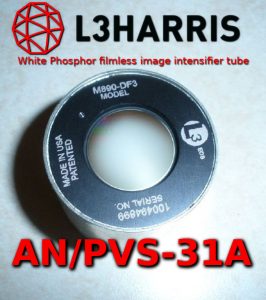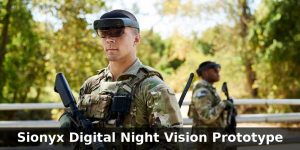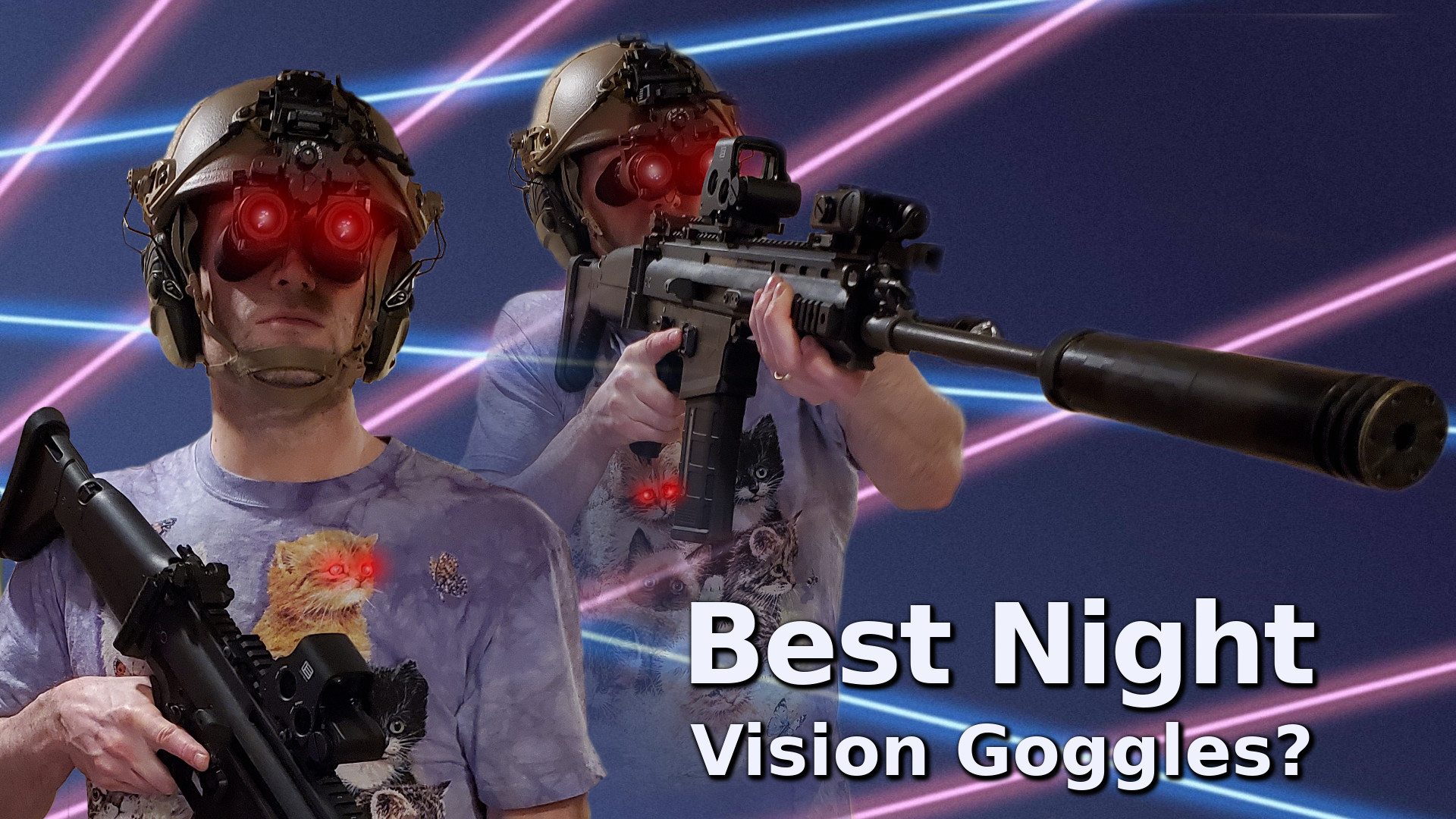TLDR:
My quest to find the best night vision goggles for the money led me to the ATN PS-31 series. Digital technology shows promise, but it still relies heavily on active infrared illuminators. With military grade L3 GPNVG “quad NODS” at $40,000 on one end and digital low light cameras for less than $1,000 on the other, the ATN PS31 strikes a balance in terms of performance vs cost.
Like most people about to spend a significant amount of money on a product, I spent a lot of time on research before making my final decision. For the uninitiated, night vision may seem fairly simple. Put on tubes, look cool and see in the dark.
However, the deeper you dive into the world of seeing stuff in the dark, the more you realize how complicated these decisions can be. With factors like weight, cost and performance coming into play, the decision is very complex. The first thing to understand is that housings are not the same as the image intensifiers.
Intensifier Tube Analog Night Vision:
 Image intensifier tubes take in whatever tiny amount of ambient light is available and amplify it such that human eyes can see it. In addition to visible light, these fascinating devices can also detect light waves in the infrared spectrum, which is normally invisible to humans.
Image intensifier tubes take in whatever tiny amount of ambient light is available and amplify it such that human eyes can see it. In addition to visible light, these fascinating devices can also detect light waves in the infrared spectrum, which is normally invisible to humans.
Intensifier tubes work in an analog fashion and are “grown” in a lab similar to the production of silicon semiconductors. Tubes are separated into 3 generations, with each generation representing a leap forward in terms of light amplification and clarity. In addition to generation, intensifier tubes are also separated by the color spectrum they display: white or green phosphorous. Generally, white phosphor is more desirable than green, although some gen 3 green phosphor tubes offer slightly better performance in extreme low light conditions.
Although intensifier tubes are bulky, heavy and expensive, this technology is still the choice of military and police around the world. While digital may be catching up, intensifier tubes are still the military standard for seeing things in the dark.
Digital Night Vision:

While there are also a growing number of digital night vision devices, current digital NVG rely too heavily on active infrared illumination to be useful for many applications. Basically, digital NODs use a very-bright IR flashlight to illuminate targets. This works great for nocturnal hunting of animals like coyotes, wild hogs and anything else that you hope doesn’t have their own night vision. However, when others in the area may have their own NODs, units that rely heavily on active IR lights are a no-go.
If you’re looking at night-time pest control, a digital night vision scope could be a way to accomplish this goal on a budget. Of course, coyotes are very clever, so it wouldn’t surprise me if they’re already working on NODs of their own.

The other problem with digital devices is refresh rate. While devices like the Syonix Aurora action camera have been pressed into service as NVG, they aren’t ready for prime time. The delay of the refresh rate makes it difficult to move and shoot at night and the lack of sensitivity means you’ll likely need a lot more active IR light to see in truly dark environments.
On the other hand, digital has many theoretical advantages. Form factor. With a digital device, the motherboard/battery could be moved to another part of the body to better balance the weight. Digital could more easily integrate with heads-up augmented reality displays. Digital could have a more panoramic field of view. Digital cameras could be shorter, so the wearer wouldn’t have long, awkward tubes hanging off their face.
Eventually, digital probably will beat intensifier tubes. But, for now, tubes are currently my pick for serious work.
Overall Winner: ATN PS31
The PS31 is a BNVD (binocular night vision device) made by ATN. Is the ATN PS31 the best piece of spec ops gear ever made? No. Units like the much more expensive L3-Harris PVS31 are built to higher spec and have an extensive history of military use by tier one operators around the world. Despite this, the ATN comes in around $4,000-$7,000 street price depending on what spec tubes you opt for. In contrast, the L3-Harris PVS31 costs over $12,000. Since the ATN delivers functional and useful, real-world binocular NVG performance at about half the cost of the L3 Harris PVS31, the ATN unit represents a significant best for the money value.
The ATN PS31 is available with several different intensifier tube options ranging in price from around $4,300 at the entry level all the way up to $7,500 MSRP for the highest quality tubes. On moonless nights with rain, heavy cloud cover and no manmade light nearby, the ATN PS31 gen 3 white phosphor version offers enough useful light amplification to navigate complex terrain on foot. Is it “just as good”? No, but it’s good enough to be a very compelling value.
Best Digital Night Vision For the Money: Sionyx Aurora
The night vision community has clearly chosen the Sionyx Aurora low light action camera as the best of its type. With prices ranging from $600-1200 depending on trim levels and a growing enthusiast community, the Sionyx Aurora has aftermarket support that competitors just can’t match. Tech blogs and night vision geeks have modded Sionyx Auroras to accept upgraded lenses, and even mounted them on helmets to give a semblance of PVS14 performance. Others in the community have weapon-mounted the Aurora, but how reliable that solution is over time remains to be seen.
Being commonly available and popular, you’ll also have better luck finding a decent Sionyx Aurora on the used market. Furthermore, because it’s a known quantity, you’d also most likely have an easier time trading or selling it if you ever want to upgrade. That said, the unit’s refresh rate lag and lack of performance in extremely low light conditions means it’s not a top choice compared to intensifier tubes. The well-known limits of current-generation digital night vision devices has led to YouTube content creators like Hoplopfheil declaring that the Sionyx is not ready for prime time.
Pros: full color, affordable, widely available.
Cons: Lack of light sensitivity, refresh rate lag, short battery life, form factor is bulky for head mounted use.
Best At Any Price: L3Harris GPNVG Ground Panoramic Night Vision Goggle
At an eye-watering price of over $42,000, the L3 GPNVG “quad nods” are the culmination of performance and stratospheric cost. GPNVG stands for Ground Panoramic Night Vision Goggles. The GPNVG became famous in pop culture through its use by spec ops teams shown in the movie Zero Dark Thirty. Appearing in video games, art and even counterculture memes, quad NODs have become a symbolic piece of kit in the world of spec ops gear. If you’ve ever used night vision, you’ll quickly understand that field of view is one of the biggest problems with these devices. The main benefit of the GPNVG system is the “panoramic” part. While some housings have up to 50* lenses, most night vision systems have a very limited field of view, generally 40*. By using four tubes, the GPNVG quad has a 97* field of view.
Detractors of the GPNVG cite the weight and bulk of the unit. Four tubes means more weight. And, weight hanging off the front of your face can be especially cumbersome. Are the GPNVG worth it for $40k? Not to me at this point in my life. But, if you want the best spec ops gear on the planet and money is no object, you can find a set on TNVC.
